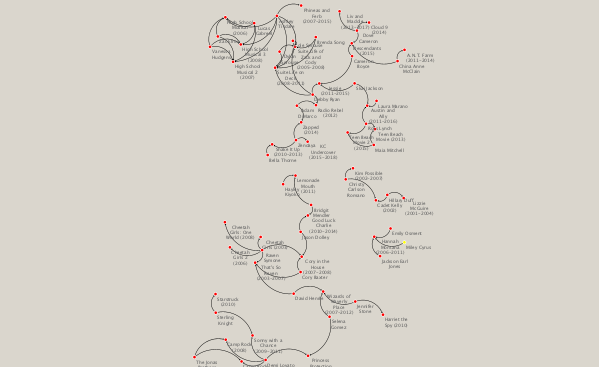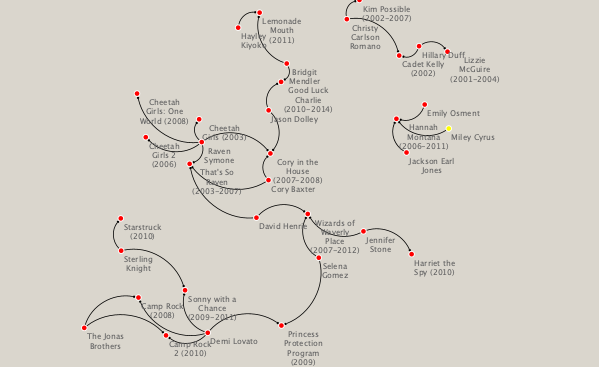Making Disney Celebrity
Initial Thoughts
For this project, I chose to go with Option B, looking at a specific era of film and television. I chose to look at Disney Studios specifically, rather than a specific genre, because of the unique influence that Disney has held over American youth, popular culture, and the creation of celebrity and stardom in the United States (and the world more widely as well), especially on Gen Z. For the project, I looked specifically at Disney-made film and television shows from 2001 to 2015. Because Disney Studios is so encompassing in the film and television industry, I focused on “Disney Originals” for the movies from this period and exlcuded cartoon and animated movies. For the sake of the project’s span, I omitted a some of the smaller Disney Originals from the period 2001-2015, basing it on the reported viewership from each movie’s premieres (Disney Originals all premiered on Disney channel rather than movie theaters). Having grown up as a part of the generation that lived with these movies and shows, I was interested in seeing how the network depicted the use of actors in the Disney Studios. In this way, I think the movie/television nodes are less about the actual project than the time period and the studio behind it. My hypothesis was that there would arise two main ideas in the network. Firstly, that the creation of celebrity was key for the development of Disney and Disney sought to create, rather than maintain, stardom. Thus, they would be responsible for the the creation of pop culture, but not be made to ensure it. Secondly, I also wanted to see how interconnected Disney Studios itself actually is. By looking at their actors and their projects, I hoped to see overlap, creating a distinct “community” of Disney actors.
The Network



You can view the Google Sheet I used to create the Cytoscape network here
The Reflection
Now having created and analyzed my network, I did think that it would be a little more interconnected than it appears to be at first glance. But, in actuality, I believe it still tells a very interesting story about Disney and the development of celebrity for its actors. Looking at the network, it visualized the different stages of Disney in coming to terms, understanding, and learning how to use its own media and actors, fashioning them into stars for its young audiences, to create cultural capital and influence.
I see three distinct periods of Disney by looking at the network:
- 2001-2007: Disney experimenting
- 2007-2013: creating Disney celebrity
- 2013-2015: offshoots
I have added the dates that the shows ran just to make it easier to understand the relationships between the studio, the actors, and the shows at each time.
The first major turning point is from 2001-2007, which saw the rise of Raven Symone and Hillary Duff as the first major teen Disney celebrities for our generation. It also illustrates Disney’s first attempts at creating a cohesive studio with a roster of actors to call on and turn to. Combining forces, Hillary Duff (Lizzie McGuire) and Christy Carlson Romano (Kim Possible) starred in Cadet Kelly. And similarly, Disney experimented with the success of Raven Symone in “That’s So Raven” by casting her as a lead in a film un related to her shows, “Cheetah Girls”, which also saw commercial success. This is also the first point in which we see Disney cross-casting actors for other projects, such as David Henrie, who was later cast on “Wizards of Waverly Place”. Even though they are separate projects, they are still by the same studio and on the same channel with the same audience. So, it indicates a willingness by Disney to create a cohesive (and recongizable) studio through its roster of actors.
The next second period seems to occur from 2007-2013, when Disney began to churn out very clear “stars”. Using a similar structure as with Raven Symone, actors like Selena Gomez, Demi Lovato, or Miley Cyrus take center, often starting with a television series and then additionally starring in a Disney Original movie. This period sees the most long-lasting stars. These names remain among the biggest in pop culture today. Interestingly, Disney starts to seem to rely more on a set of actors, adding them to many different Disney projects. It also creates a web wherein celebrity, especially Disney celebrity, is always interconnected and not entirely independent from the studio because of the studio’s own cultivation of these actors.
But, there is also an interesting phenomenon when certain actors reach a certain level of fame and celebrity through their shows or movies. They cease to be introduced into other Disney projects. The network shows this in the cmore clustered, heavily concentrated areas. So, Disney creates these long-lasting stars but never really retains them. Raven Symone, while big, was not necessarily as long-lasting and so came back onto Corey in the House (2007-2008). Meanwhile, Mileuy Cyrus, with the success of Hannah Montana, remained “isolated” from the rest of the Disney world (other than a few cross-over episodes not shown in the network). A similar pattern is seen with High School Musical - the noticable exception being Ashley Tisdale. This remains suprising to me why Disney seems to not continue to foster its newfound stars once they achieve celebrity, given their tendency as a studio to create both the roster of actors and stardom.
The final period of the network (2013-2015) shows Disney trying to create more celebrity by giving secondary characters from successful shows their own projects. The longer, less-clustered parts of the network highlight this. Once again, it shows the cohesive roster of actors and shared nature of the Disney Studio. But, rather than simply using the same actors on different projects, they actively center them in Disney shows. The result is a celebrity that feels more produced and manufactured, as opposed to the overnight success of early Disney stars. This period shows a studio that understands its own cultural influence and power in creating celebrity.
Given more time, I think it would be interesting to expand the network to include the time period up to today. Disney still occupies an important place in pop culture with its continued production of movies and television, but also because of its role in originating much of the celebrity that exist today. I would like to see how Disney has continued to shift and evolve and if they still seek to create celebrity in a similar sense and with a similar model as before.

